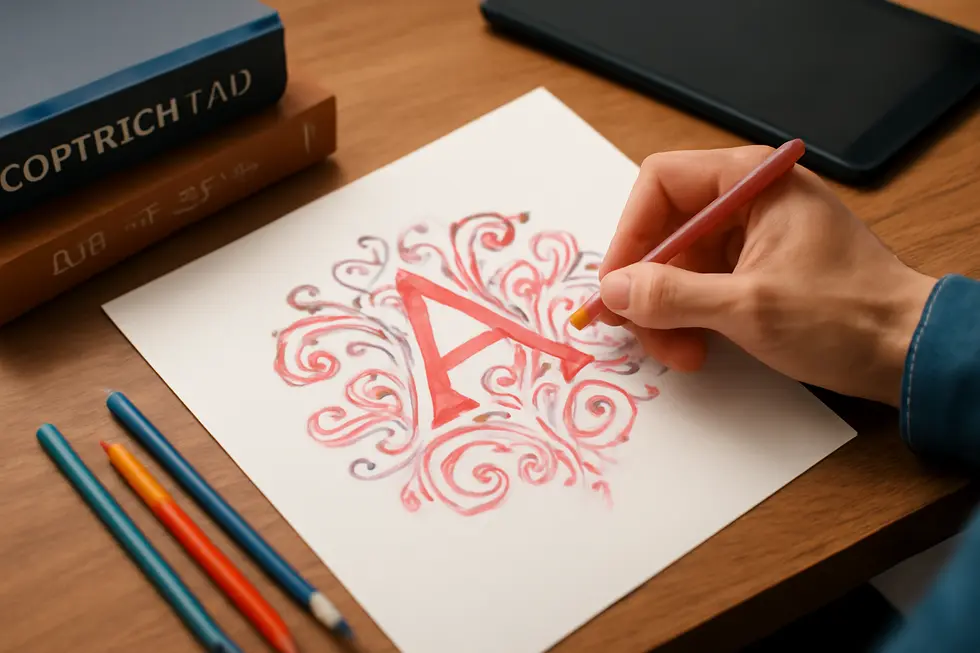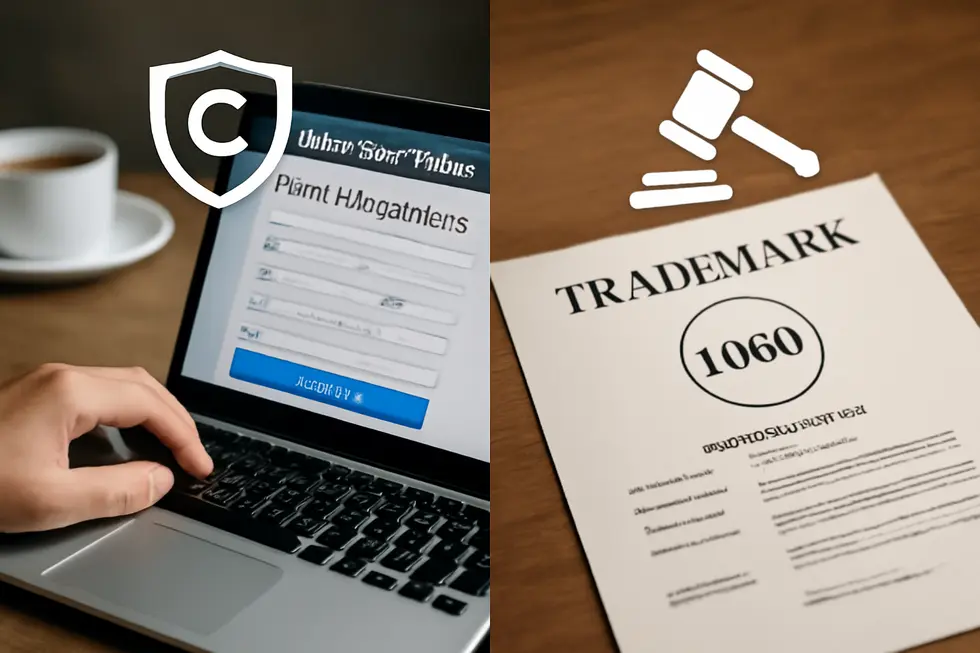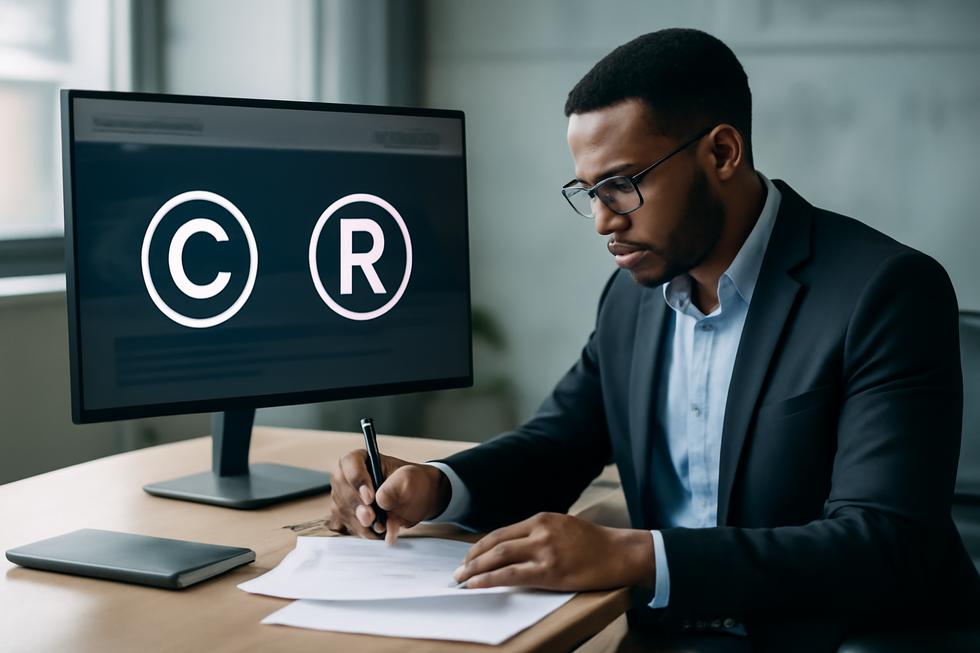Introduction
Protecting your logo is a fundamental step for any business owner seeking to secure their brand’s identity and creative assets. A logo is more than just an image; it embodies your company’s values and reputation. Understanding how to get a logo copyrighted ensures your artwork receives legal recognition and protection against unauthorized use. This process not only establishes clear ownership but also strengthens your ability to enforce your rights in court. The journey to copyright involves several critical components: the formal registration process lays the legal groundwork; meeting originality and creativity requirements ensures your logo qualifies for protection; distinguishing between copyright and trademark helps you navigate the nuances of intellectual property law; and combining both forms of protection provides comprehensive security for your brand in the marketplace. These four elements work together to create a robust shield around your logo, securing your investment in branding for the future.
Tables of Contents
Chapter 1: Understanding How Do You Get a Logo Copyrighted: The Formal Registration Process
- Navigating the Copyright Registration Journey: Securing Your Logo as Visual Artwork
- Harnessing Trademark Registration for Robust Logo and Brand Protection
- Distinguishing Copyright from Trademark: Protecting Your Logo’s Design and Brand Identity
- Navigating Trademark Registration Steps: Securing Legal Rights for Your Logo
- Strategic Dual Protection: Combining Copyright and Trademark for Your Logo
Chapter 2: Exploring How Do You Get a Logo Copyrighted: Requirements for Originality and Creativity
- Decoding Originality: The Creative Threshold Your Logo Must Clear for Copyright Protection
- Mastering the Copyright Registration Journey: Essential Steps to Secure Your Logo’s Artistic Rights
- Understanding the Boundaries of Copyright Protection for Logos: Originality, Creativity, and Legal Limits
- Navigating the Dual Protection of Logos: How Copyright and Trademark Complement Each Other
- Mastering Multi-Layered Legal Protections: Integrated Strategies to Secure Your Logo’s Copyright and Brand Identity
Chapter 3: Distinguishing How Do You Get a Logo Copyrighted: Copyright Versus Trademark Protection
- Unraveling Copyright’s Role in Logo Protection: Artistic Creation Versus Brand Identity
- Unraveling Trademark Registration: Securing Your Logo’s Commercial Identity
- Clarifying the Legal Boundaries: Copyright and Trademark Roles in Logo Protection
- Maximizing Legal Safeguards: The Power of Combining Copyright and Trademark for Logo Protection
- Navigating the Essential Steps to Secure Copyright and Trademark Protection for Your Logo
Chapter 4: Strategies for How Do You Get a Logo Copyrighted: Combining Copyright and Trademark for Complete Logo Protection
- Navigating Copyright Protection for Logos: Securing Creative Ownership and Legal Enforcement
- Mastering Trademark Registration: Securing Your Logo’s Identity Beyond Copyright
- Maximizing Logo Security: Integrating Copyright and Trademark Protections for Full-Spectrum Legal Defense
- Navigating the Dual Registration Process: Essential Steps to Secure Copyright and Trademark for Your Logo
- Maximizing Logo Security: Expert Insights on Merging Copyright and Trademark Protections
Chapter 1: Understanding How Do You Get a Logo Copyrighted: The Formal Registration Process

1. Navigating the Copyright Registration Journey: Securing Your Logo as Visual Artwork
To officially get a logo copyrighted, it must be registered as a visual artwork with the U.S. Copyright Office. While copyright exists automatically upon creation if the design is original, registration offers vital legal advantages. The process begins by creating an account on the U.S. Copyright Office website and selecting the “visual arts” category, under which logos fall. Applicants then complete an online form detailing the logo and claimant information, upload a clear image of the logo, and pay the registration fee—typically ranging from $35 to $55.
Once submitted, the application undergoes review, taking about three to five months to finalize. Registration provides a public record of ownership and enhances the owner’s ability to enforce rights, including suing for statutory damages and attorney fees if infringement occurs. Importantly, copyright protects the artistic elements of a logo, such as original pictorial or graphic features, not basic shapes or slogans—these fall under trademark protections.
This formal registration solidifies your logo’s legal standing beyond the automatic protection granted at creation, making it essential for robust intellectual property security. For detailed official guidance, visit the U.S. Copyright Office website. For additional insights on trademark protections that complement copyright, see our resource on trademark protection for business names and logos.
2. Harnessing Trademark Registration for Robust Logo and Brand Protection
While copyright safeguards a logo’s artistic design, trademark registration uniquely protects the logo as a commercial brand identifier. This dual protection is essential because trademarks give exclusive rights to use the logo in commerce, preventing others in your industry from adopting confusingly similar marks. The trademark registration process begins with a clearance search to confirm your logo’s uniqueness and avoid legal conflicts. Next, you file an application through the United States Patent and Trademark Office’s online system, selecting the appropriate format — often a stylized/design mark that reflects the logo’s visual elements. During examination, the USPTO may issue office actions requiring clarification or corrections, so timely, precise responses are critical to advancing your application. Once preliminarily approved, the logo is published for opposition, allowing third parties to challenge your claim. If no challenges arise, your trademark will be registered, granting federal protection and exclusive nationwide rights. Maintaining your trademark involves monitoring infringement and renewing registrations, with a strong brand portfolio further enhancing protection. By complementing copyright registration with trademark registration, you ensure comprehensive legal defense covering both creative expression and commercial brand identity. For detailed guidance on this process, visit the trademark registration and protection resource and explore the USPTO’s official trademark application portal.
3. Distinguishing Copyright from Trademark: Protecting Your Logo’s Design and Brand Identity
Understanding the distinct roles of copyright and trademark is essential when protecting a logo. Copyright safeguards the original artistic expression of a logo, automatically applying once the design is fixed in a tangible form, such as a digital file or print. While this offers baseline protection against unauthorized copying, formally registering with the U.S. Copyright Office significantly strengthens legal remedies, allowing the owner to pursue infringement claims. However, copyright protection focuses solely on the creative aspects and does not cover the logo’s use as a brand identifier.
Conversely, trademark protection secures the logo’s function as a symbol that identifies the source of goods or services. This protection arises mainly through registration with the U.S. Patent and Trademark Office (USPTO), granting exclusive rights to use the logo commercially and prevent similar marks that could confuse consumers. Trademark registration involves a detailed application process, including specifying the logo’s stylized design and paying applicable fees.
Because copyright and trademark protect different facets of a logo, many businesses pursue both registrations. This dual approach maximizes legal safeguards by defending the logo’s artistic integrity and its commercial brand identity simultaneously. To explore more on how a trademark shields your brand, refer to trademark protection for business names and logos. For the official copyright registration process, visit the U.S. Copyright Office.
4. Navigating Trademark Registration Steps: Securing Legal Rights for Your Logo
Although copyrights protect original artistic creations automatically at fixation, logos mainly gain stronger commercial protection through trademark registration. This process shields your logo as a distinctive brand identifier, preventing competitors from using confusingly similar marks in commerce nationwide. To begin, conduct a thorough search on the USPTO’s Trademark Electronic Search System (TESS) to ensure your logo is unique and avoids conflicts with existing marks. Then, decide if you want to register your logo as a stylized/design mark or a standard character mark, reflecting its visual elements. Prepare your application carefully by assembling a clear image of the logo, identifying associated goods or services, and selecting appropriate trademark classes. Filing occurs via the USPTO’s online Trademark Electronic Application System (TEAS), where you will submit specimens demonstrating actual logo use in commerce and pay the required fees. Throughout examination, timely responses to office actions maintain your application’s viability. This thorough registration process typically spans 8 to 12 months and culminates in federal protection, offering robust legal remedies against unauthorized commercial use. To understand how trademark laws intersect with protecting your logo’s brand identity, visit this resource on trademark protection for business name and logo for additional insights.
5. Strategic Dual Protection: Combining Copyright and Trademark for Your Logo
Effectively protecting a logo as intellectual property demands a strategic approach that integrates both copyright and trademark protections. Copyright safeguards the artistic design itself, automatically applying upon the logo’s creation if it reflects sufficient originality. However, registering the copyright with the U.S. Copyright Office strengthens legal rights and allows for enforcement against infringement. This process requires submitting an online application, providing a clear image of the logo, and paying a registration fee, typically around $55, with approval taking several months.
Trademark protection is equally crucial, focusing on the logo’s role as a brand identifier in commerce. Registration through the U.S. Patent and Trademark Office involves searching for conflicting marks, filing through the Trademark Electronic Application System, and navigating examination steps before earning exclusive nationwide rights to the logo’s use. This grants powerful enforcement tools, including federal litigation and customs protection.
Together, these protections complement each other, ensuring your logo’s artistic creativity and commercial identity are both legally secured. Consulting intellectual property professionals can guide you through this dual process and help develop effective enforcement strategies. For further guidance on trademark registration procedures, visit this detailed resource. For more on how copyright protects your creative works, see copyright and trademark law for business owners.
Chapter 2: Exploring How Do You Get a Logo Copyrighted: Requirements for Originality and Creativity

1. Decoding Originality: The Creative Threshold Your Logo Must Clear for Copyright Protection
To secure copyright protection for a logo, it must satisfy the crucial originality requirement, meaning the design must be independently created without copying from existing works. This originality standard, though not stringent, demands that the logo embody at least a modicum of creativity—a minimal but genuine creative input such as distinctive shape, color combinations, typography, or composition. Merely basic or generic designs consisting of simple geometric forms often fail this test.
Copyright law safeguards the artistic expression registered in the logo, not the underlying ideas or concepts. Thus, the logo should reflect unique design choices that distinguish it from purely functional or commonplace symbols. Additionally, copyright ownership often depends on who created the logo: employers typically own copyrights for logos created by employees in the scope of work, while freelancers may transfer rights through contracts.
For business owners seeking more detailed explanations on originality and protection scope, authoritative resources like the University of Michigan Library’s copyright basics guide provide valuable insight. Striking the balance between creativity and originality is a pivotal step toward lasting legal protection for your logo.
2. Mastering the Copyright Registration Journey: Essential Steps to Secure Your Logo’s Artistic Rights
Securing copyright protection for a logo begins with confirming that the design meets the threshold of originality and creativity. The logo must be an original visual artwork fixed in a tangible form, such as a digital image or printed copy. Simple shapes, generic symbols, or mere business names and slogans do not qualify for copyright. Once originality is established, the process involves submitting a detailed application to the U.S. Copyright Office. This includes classifying the work under visual arts, uploading a clear copy of the logo, and providing proof of ownership.
Applicants create an online account, complete the required forms, and pay a fee, typically around $35. After submission, the application receives a tracking number and undergoes a review to ensure completeness. There is a 30-day public notice period for objections before official registration. Upon approval, the copyright office issues a certificate confirming legal protection. While copyright safeguards the logo’s artistic elements, trademark registration is essential for protecting the logo’s commercial use as a brand identifier. This dual approach offers comprehensive security against unauthorized use or duplication.
For a thorough walkthrough of this process, refer to official resources such as the U.S. Copyright Office website and expert guides like Balaji Certification Services. For additional insight on protecting logos as brand identifiers, see trademark protection for business names and logos.
3. Understanding the Boundaries of Copyright Protection for Logos: Originality, Creativity, and Legal Limits
Copyright protection for logos hinges on meeting strict criteria of originality and creative authorship. To qualify, a logo must possess more than basic geometric shapes or common symbols; it needs a degree of artistic creativity fixed in a tangible form. Without these elements, copyright law does not apply. Additionally, the law demands human authorship, excluding works generated solely by artificial intelligence or automated processes from protection. This leaves logos created with minimal human input vulnerable under copyright.
Moreover, copyright safeguards only the unique artistic expression of a logo, not the underlying ideas or functional aspects, allowing others to design similar logos if they do not replicate the exact creative elements. Due to these constraints, trademark registration becomes essential for securing brand identity and exclusive commercial rights to a logo. This layered protection strategy is critical since trademarks defend the logo’s use as a brand identifier, complementing the artistic protections granted through copyright. For those interested in exploring these distinctions further, see more on trademark protection for business names and logos.
For a detailed explanation of the originality requirement, refer to the University of Michigan’s copyright guidelines. This understanding helps clarify why not all logos are eligible for copyright and why dual protection is often necessary.
4. Navigating the Dual Protection of Logos: How Copyright and Trademark Complement Each Other
A logo’s protection often involves navigating the intertwined roles of copyright and trademark law. Copyright safeguards the logo’s unique artistic expression—its original design elements and creative arrangement—as long as it meets the modest threshold of originality and creativity. However, copyright does not extend to the logo’s commercial function as a brand identifier. That critical role falls under trademark law, which protects logos used in commerce to distinguish goods or services and prevent marketplace confusion.
This distinction means a logo can enjoy dual protections: copyright registration secures the artistic work itself, while trademark registration protects the logo’s use as a brand symbol. Trademark law evaluates distinctiveness and consumer recognition to grant exclusive rights, ensuring the logo’s value in business identity. Consequently, many creators pursue both copyright and trademark registrations to fully shield their logos from infringement or misuse. Such a dual approach marries the defense of creative expression with the assurance of commercial exclusivity, offering comprehensive security for logos.
For more on securing brand identity through trademarks, visit trademark protection for business names and logos.
Additional insight on copyright originality standards is available from the University of Michigan Library: https://guides.lib.umich.edu/copyrightbasics/copyrightability
5. Mastering Multi-Layered Legal Protections: Integrated Strategies to Secure Your Logo’s Copyright and Brand Identity
Securing a logo’s legal protection demands a nuanced approach that integrates copyright, trademark, and sometimes design patent safeguards. Copyright protection arises once a logo is fixed in a tangible form and shows minimal originality—typically covering the graphic creativity embedded in the design. Formal registration with the U.S. Copyright Office noticeably enhances enforcement rights, allowing owners to seek statutory damages and attorney fees if infringement occurs. However, since logos serve primarily as source identifiers, trademark registration with the U.S. Patent and Trademark Office is indispensable for exclusive commercial use rights and broader nationwide protection. Trademark law guards the logo’s function as a brand symbol, complementing copyright’s focus on artistic expression. In some unique cases, design patents can protect ornamental aspects of a logo’s appearance, though this path is less common due to its complexity. Notably, overly simple or generic logos may fail copyright eligibility, underscoring the importance of creativity in the initial design. By adopting this comprehensive, layered strategy, logo creators effectively shield both their artistic creation and its commercial identity against unauthorized use or duplication. For an in-depth overview of trademark protection for logos and business names, see this resource on trademark protection. External guidance on the copyright registration process is available at the U.S. Copyright Office website: https://graphicdesigneye.com/how-to-copyright-t-shirt-design/
Chapter 3: Distinguishing How Do You Get a Logo Copyrighted: Copyright Versus Trademark Protection

1. Unraveling Copyright’s Role in Logo Protection: Artistic Creation Versus Brand Identity
Copyright protection for a logo begins the moment the design is created and fixed in a tangible form, such as a digital file or printed image. This protection covers the original artistic expression behind the logo, safeguarding it as a creative work. However, copyright does not extend to the role the logo plays as a source identifier in commerce—that is the realm of trademark law.
While copyright arises automatically, registering the logo with the U.S. Copyright Office can provide valuable legal advantages, including stronger enforcement rights against unauthorized replication of the design itself. In contrast, trademark protection focuses on preventing consumer confusion by protecting logos used to identify and distinguish goods or services in the marketplace. This protection is acquired through registration with the United States Patent and Trademark Office (USPTO), which grants exclusive usage rights tied specifically to commercial branding.
For businesses, understanding this fundamental distinction is crucial: copyright preserves the creativity of the logo’s visual elements, whereas trademark secures its commercial use as a brand symbol. Many logo owners pursue both protections to ensure their designs are fully shielded—copyright for artistic integrity and trademark for brand exclusivity. For detailed trademark insights, consult resources on trademark protection for business names and logos.
2. Unraveling Trademark Registration: Securing Your Logo’s Commercial Identity
While copyright safeguards the creative elements of a logo, trademark protection serves a different but complementary purpose: it secures the logo’s role as a brand identifier in commerce. Trademark rights arise when a logo is used to distinguish goods or services, preventing others from adopting confusingly similar marks that could mislead consumers. Unlike copyright, which protects the artistic design automatically upon creation, trademark protection requires registration with the U.S. Patent and Trademark Office (USPTO) or relevant state offices for the strongest legal benefits. This registration process includes searching existing trademarks to avoid conflicts, submitting an application with a specimen showing the logo’s commercial use, and paying requisite fees ranging around $250 to $350 per class of goods or services. Registered trademarks grant nationwide rights, the ability to sue for infringement, and permission to use the ® symbol, signaling official legal protection. Maintaining a trademark involves timely renewals and declarations of continued commerce usage, allowing indefinite protection as long as the mark remains active. Employing trademark registration alongside copyright establishes a robust defense, protecting not only the logo’s artistic design but also its unique commercial identity. Learn more about the importance of trademark protection and the registration process at trademark protection for business name and logo.
3. Clarifying the Legal Boundaries: Copyright and Trademark Roles in Logo Protection
Copyright and trademark protections serve distinct yet complementary purposes when it comes to logos. Copyright safeguards the original artistic expression embedded in a logo’s design, automatically coming into effect once the work is fixed in a tangible form. Registration with the U.S. Copyright Office, though optional, strengthens enforcement rights and is valid for the author’s life plus 70 years. In contrast, trademark protection focuses on the logo’s role as a source identifier in commerce, preventing others from confusing consumers by using similar marks. Trademark rights arise through commercial use and may be secured through registration with the USPTO, providing indefinite protection as long as the mark remains in active use and is properly maintained. While copyright bars replication of the artistic work itself, it does not prevent others from using similar designs in branding, which marks the critical role trademarks play in protecting brand identity. This dual framework ensures that a logo’s unique design and its commercial significance are legally shielded, offering creators and businesses comprehensive protection. For a deeper exploration of trademarks alongside copyright, see more about trademark protection for business names and logos. External insights into these distinctions can also be found in Larson Patent Law’s detailed explanation of trademark versus copyright for logos.
4. Maximizing Legal Safeguards: The Power of Combining Copyright and Trademark for Logo Protection
To effectively protect a logo, many businesses adopt a dual protection strategy combining copyright and trademark registrations. Copyright safeguards the logo’s original artistic elements, granting exclusive rights to reproduce and display its creative design. This protection arises automatically once the logo is fixed in a tangible medium but gains stronger legal footing through formal registration. However, copyright alone does not shield against others using similar logos as brand identifiers in commerce.
Trademark protection complements this by securing the logo’s role as a distinct source identifier of goods or services. Registration with the appropriate trademark office affords exclusive rights to prevent confusingly similar marks from entering the market. This dual approach ensures both the artistic expression and the commercial branding of a logo receive robust legal defense.
By registering a logo under both systems, owners obtain a broad shield against infringement—copyright deters unauthorized copying of design, while trademark wards off marketplace confusion. This integrated strategy strengthens enforcement, especially in court, and preserves brand uniqueness. For practical guidance on trademark and copyright interplay within brand identity, exploring trademark and copyright law resources is highly recommended.
5. Navigating the Essential Steps to Secure Copyright and Trademark Protection for Your Logo
Obtaining legal protection for a logo requires understanding distinct procedures for copyright and trademark registration. Copyright safeguards a logo’s original artistic design by registering it as a creative visual work with the U.S. Copyright Office. This process involves submitting an application that includes detailed information and a clear image of the logo, paying a nominal fee (typically between $35 and $50), and waiting for official certification. Copyright grants protection against unauthorized reproduction of the logo’s specific design elements for the life of the author plus 70 years.
Conversely, trademark registration protects the logo as a brand identifier that distinguishes goods or services in commerce. This involves conducting a trademark search to confirm uniqueness, filing an application with the U.S. Patent and Trademark Office, paying the higher registration fees (around $275 to $325), and responding to any examination queries. Trademark rights endure as long as the mark is actively used and renewed every ten years.
While copyright focuses on artistic originality, trademark centers on commercial identity, making it common for logos to hold both protections simultaneously. This dual strategy effectively deters unauthorized copying and protects the brand’s reputation and market presence. For deeper insights, visit the extensive guide on trademark protection for business name and logo.
For official procedures and comprehensive details, the U.S. Copyright Office website remains the primary resource for copyright registration.
Chapter 4: Strategies for How Do You Get a Logo Copyrighted: Combining Copyright and Trademark for Complete Logo Protection

1. Navigating Copyright Protection for Logos: Securing Creative Ownership and Legal Enforcement
Copyright protection automatically attaches to a logo’s original artistic design upon its creation, recognizing the creative work itself. However, while this automatic protection covers the artwork, formal registration with the U.S. Copyright Office strengthens your legal position significantly. Registering your logo—typically by submitting a clear image and completing an online application—provides an official certificate, which is crucial for enforcing rights in court and seeking damages for infringement. It is important to note, though, that copyright safeguards the visual expression of the logo, not its use as a brand identifier in commerce.
Many logos may not qualify if the design lacks sufficient originality, such as those consisting solely of simple geometric shapes. In those cases, trademark protection better serves the goal of brand exclusivity. Still, copyright protection remains vital for the artistic elements and adds an important layer of defense against copying.
By integrating copyright registration into your broader protection strategy, you secure ownership over the logo’s creative design before pursuing trademarks that protect commercial use. This dual approach fortifies your position against infringement and unauthorized duplication. For more detailed guidance on copyright essentials relevant to business owners, consider exploring copyright brand name and logo protection.
External reference: https://www.traverselegal.com/blog/how-is-copyright-law-related-to-intellectual-property/
2. Mastering Trademark Registration: Securing Your Logo’s Identity Beyond Copyright
To fully safeguard a logo, simply copyrighting its artistic design is not enough; trademark registration plays a vital role in protecting its use as a unique brand identifier. While copyright secures the original graphic work upon creation, trademark registration with the USPTO extends protection by preventing others from using confusingly similar logos commercially. This process begins with a thorough trademark search using the USPTO’s TESS database to avoid conflicts with existing marks. Then, applicants select the proper trademark type—stylized or design marks typically apply to logos—and file an application online via the TEAS system, specifying the goods or services covered. Federal trademark registration grants exclusive nationwide rights and robust enforcement, far surpassing state-level protections. For greater security, consider filing separate trademarks for both the logo design and the brand name, as combining them into one mark can leave each element vulnerable individually. Though not required, consulting a trademark attorney can simplify this complex process and enhance registration success. This dual strategy of copyright and trademark registration ensures that your logo is defended both as an artistic creation and a business symbol, providing comprehensive legal coverage. More details on trademark protection for logos can be found at Trademark Protection for Business Name and Logo.
3. Maximizing Logo Security: Integrating Copyright and Trademark Protections for Full-Spectrum Legal Defense
Protecting a logo effectively requires leveraging both copyright and trademark protections, which secure distinct but complementary rights. Copyright safeguards the logo’s original artistic design once it is fixed in a tangible form, offering exclusive rights against unauthorized copying of the creative expression. While copyright arises automatically upon creation if the logo is sufficiently original, formal registration with the U.S. Copyright Office strengthens enforcement capabilities, allowing owners to file infringement lawsuits and seek damages.
Trademark protection addresses the commercial use of the logo as a brand identifier. Registering the mark with the USPTO not only prevents others from using confusingly similar logos in the marketplace but also confers nationwide exclusive rights tied to specific goods or services. Businesses often file separate trademarks for the logo’s design element and the associated wordmark to maintain flexibility and broader protection.
Combining these intellectual property tools creates robust, layered safeguards: copyright defends the artistic integrity while trademark guards the brand identity in commerce. This dual strategy integrates seamlessly into business approaches, supporting brand trust and proactive enforcement against misuse. For detailed steps on trademark strategies, consult valuable resources on trademark protection for business names and logos.
For a thorough guide on copyright registration processes, including submitting applications and deposit copies, visit the official U.S. Copyright Office tutorial at https://www.youtube.com/watch?v=UZBKHPBMITM.
4. Navigating the Dual Registration Process: Essential Steps to Secure Copyright and Trademark for Your Logo
Protecting a logo effectively involves a dual registration process that addresses both its artistic creation and commercial use. First, copyright registration secures the original design elements of your logo. To do this, submit an application to the U.S. Copyright Office online, providing clear images and necessary descriptions, then pay the registration fee. This formalizes ownership and enhances legal remedies against copying. Parallel to this, trademark registration safeguards your logo’s function as a brand identifier in commerce. Begin by conducting a thorough trademark search to ensure your logo does not conflict with existing marks. Then, submit a trademark application detailing how your logo will be used commercially along with the relevant product or service classes. The trademark office reviews applications, publishes them for public opposition, and, if unchallenged, grants registration typically lasting ten years with renewals. Combining these protections ensures your logo’s artistic expression is guarded against unauthorized reproduction while its commercial use is legally monopolized. Seeking guidance from intellectual property professionals can streamline this process. For deeper insight on trademark safeguards for logos, explore trademark protection for business names and logos. Official procedural details can be found via the U.S. Copyright Office’s resources.
5. Maximizing Logo Security: Expert Insights on Merging Copyright and Trademark Protections
To achieve comprehensive legal protection for your logo, it is essential to understand how copyright and trademark registrations complement each other. Copyright safeguards the logo’s original artistic expression from the moment it is created, but formal registration with the Copyright Office enhances legal enforceability and evidentiary strength. This involves submitting an application with detailed descriptions and clear copies of the logo, subject to a public notice period allowing objections. Meanwhile, trademark registration focuses on protecting the logo’s role as a commercial brand identifier, preventing others from using similar marks that might confuse consumers. This registration extends to service marks and can include related elements like trade dress, aligning with your overall branding strategy. Combining these protections creates a layered defense: copyright secures creative rights, while trademarks uphold commercial identity. Experts recommend ensuring your logo’s originality, seeking guidance from intellectual property professionals to manage filings, and monitoring usage to avoid weakening rights over time. This strategic, dual approach best secures your logo against infringement and misuse. For more detailed guidance on copyright processes and strategic protection combinations, see Balaji Certification Services’ comprehensive resource.
Final thoughts
Securing copyright for your logo provides a crucial layer of legal protection that formalizes your ownership and empowers enforcement against unauthorized copying. However, understanding the process requires attention to both the necessary registration steps and the creative standards your logo must meet to qualify. Additionally, recognizing the distinctions between copyright and trademark protection enables you to leverage each tool effectively for your business needs. Ultimately, the most robust protection stems from combining copyright with trademark safeguards — a comprehensive approach that protects both your logo’s artistic originality and its commercial brand significance. As a business owner, investing in these protections not only safeguards your intellectual property but also preserves the value and reputation your logo represents. Taking these actionable steps today ensures your brand’s legacy remains secure and legally protected tomorrow.
Your IP is the foundation of your success – let’s protect it together before it’s too late. We can’t wait to help you turn your ideas into legally secured assets.
About us
undefined


